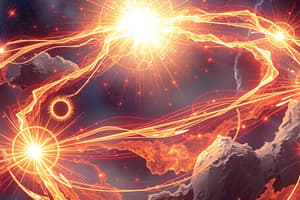Podcast
Questions and Answers
What is the primary role of the strong nuclear force in atomic structure?
What is the primary role of the strong nuclear force in atomic structure?
- Generates electric and magnetic fields.
- Causes radioactive decay of atoms.
- Holds protons and neutrons together in atomic nuclei. (correct)
- Influences the motion of celestial bodies.
Which statement accurately reflects Newton's Second Law of Motion?
Which statement accurately reflects Newton's Second Law of Motion?
- An object will remain at rest unless acted upon by a net force.
- Force is equal to mass multiplied by acceleration. (correct)
- Every action has an equal and opposite reaction.
- Objects in motion travel in a linear path unless a force acts on them.
How is potential energy defined in relation to gravitational force?
How is potential energy defined in relation to gravitational force?
- Energy stored based on an object's position above the ground. (correct)
- Energy due to an object's speed.
- Energy stored based on the temperature of the object.
- Energy associated with the kinetic energy of surrounding objects.
Which of the following best describes electromagnetic waves?
Which of the following best describes electromagnetic waves?
What principle does the second law of thermodynamics illustrate?
What principle does the second law of thermodynamics illustrate?
What does Ohm's Law relate in an electrical circuit?
What does Ohm's Law relate in an electrical circuit?
In the context of quantum mechanics, what does the term 'wave-particle duality' imply?
In the context of quantum mechanics, what does the term 'wave-particle duality' imply?
What is indicated by the equation $E = mc²$ in the context of relativity?
What is indicated by the equation $E = mc²$ in the context of relativity?
Flashcards are hidden until you start studying
Study Notes
Key Concepts in Physics
Fundamental Forces
-
Gravitational Force
- Attraction between masses.
- Governs motion of celestial bodies.
-
Electromagnetic Force
- Interacts with charged particles.
- Responsible for electricity, magnetism, and light.
-
Weak Nuclear Force
- Responsible for radioactive decay and nuclear reactions.
-
Strong Nuclear Force
- Holds protons and neutrons together in atomic nuclei.
Laws of Motion
-
Newton's First Law
- An object in motion stays in motion unless acted upon by an external force.
-
Newton's Second Law
- Force equals mass times acceleration (F = ma).
-
Newton's Third Law
- For every action, there is an equal and opposite reaction.
Energy
-
Kinetic Energy (KE)
- Energy of motion: KE = 1/2 mv² (m = mass, v = velocity).
-
Potential Energy (PE)
- Stored energy due to position: PE = mgh (m = mass, g = acceleration due to gravity, h = height).
-
Conservation of Energy
- Energy cannot be created or destroyed, only transformed.
Waves and Oscillations
-
Wave Properties
- Wavelength, frequency, amplitude, speed.
-
Types of Waves
- Mechanical (requires medium) and electromagnetic (does not require medium).
-
Sound Waves
- Longitudinal waves that travel through media.
Thermodynamics
-
First Law
- Energy conservation, ∆U = Q - W (ΔU = change in internal energy, Q = heat added, W = work done).
-
Second Law
- Entropy of an isolated system always increases; heat cannot spontaneously flow from cold to hot.
-
Thermal Energy Transfer
- Conduction (direct contact), convection (fluid movement), radiation (electromagnetic waves).
Electricity and Magnetism
-
Ohm's Law
- V = IR (V = voltage, I = current, R = resistance).
-
Magnetic Fields
- Defined by field lines; create force on moving charges.
-
Electromagnetic Induction
- Changing magnetic fields induce electric current.
Modern Physics
-
Quantum Mechanics
- Describes behavior of particles at atomic and subatomic levels.
-
Relativity
- Special Relativity: time and space are relative; mass and energy are equivalent (E = mc²).
- General Relativity: gravity is the curvature of spacetime.
-
Particle Physics
- Study of elementary particles and fundamental interactions.
Applications of Physics
-
Engineering
- Application of physics principles in design and construction of structures.
-
Medical Physics
- Use of physics concepts in medical technologies (e.g., imaging, radiation therapy).
-
Astronomy
- Application of physics to understand celestial phenomena and the universe.
Fundamental Forces
- Gravitational Force attracts objects with mass. It governs the movement of planets around the sun.
- Electromagnetic Force acts on charged particles, influencing electricity, magnetism, and light.
- Weak Nuclear Force drives radioactive decay and nuclear reactions.
- Strong Nuclear Force binds protons and neutrons inside the atomic nucleus.
Laws of Motion
- Newton's First Law states that an object at rest will stay at rest, and an object in motion will stay in motion with the same speed and direction unless acted upon by a force.
- Newton's Second Law defines the relationship between force, mass, and acceleration: force equals mass times acceleration (F = ma).
- Newton's Third Law describes how for every action, there is an equal and opposite reaction.
Energy
- Kinetic Energy (KE) is the energy of motion, calculated as KE = 1/2 mv² (m = mass, v = velocity).
- Potential Energy (PE) is stored energy due to position, calculated as PE = mgh (m = mass, g = acceleration due to gravity, h = height).
- Conservation of Energy states that energy cannot be created or destroyed, only transformed from one type to another.
Waves and Oscillations
- Wave Properties are characterized by wavelength, frequency, amplitude, and speed
- Types of Waves include mechanical waves, requiring a medium to travel, and electromagnetic waves, which do not need a medium.
- Sound Waves are longitudinal waves that travel through a medium, like air.
Thermodynamics
- First Law of Thermodynamics expresses energy conservation, stating that the change in internal energy (∆U) equals the heat added (Q) minus the work done (W) - ∆U = Q - W.
- Second Law of Thermodynamics states that the entropy of an isolated system always increases, indicating that heat spontaneously flows from a hotter object to a colder one.
- Thermal Energy Transfer can occur through conduction (direct contact), convection (fluid movement), and radiation (electromagnetic waves).
Electricity and Magnetism
- Ohm's Law states the relationship between voltage (V), current (I), and resistance (R) - V = IR.
- Magnetic Fields are represented by field lines; they create force on moving charges.
- Electromagnetic Induction explains how changing magnetic fields induce electric current.
Modern Physics
- Quantum Mechanics describes how particles behave at atomic and subatomic levels.
- Relativity consists of Special Relativity, where time and space are relative, and mass and energy are equivalent (E = mc²), and General Relativity, which explains gravity as the curvature of spacetime.
- Particle Physics investigates elementary particles and their interactions.
Applications of Physics
- Engineering applies physics principles to design and construct structures.
- Medical Physics utilizes physics concepts for medical technologies, including imaging and radiation therapy.
- Astronomy relies on physics to understand celestial phenomena and the universe.
Studying That Suits You
Use AI to generate personalized quizzes and flashcards to suit your learning preferences.




